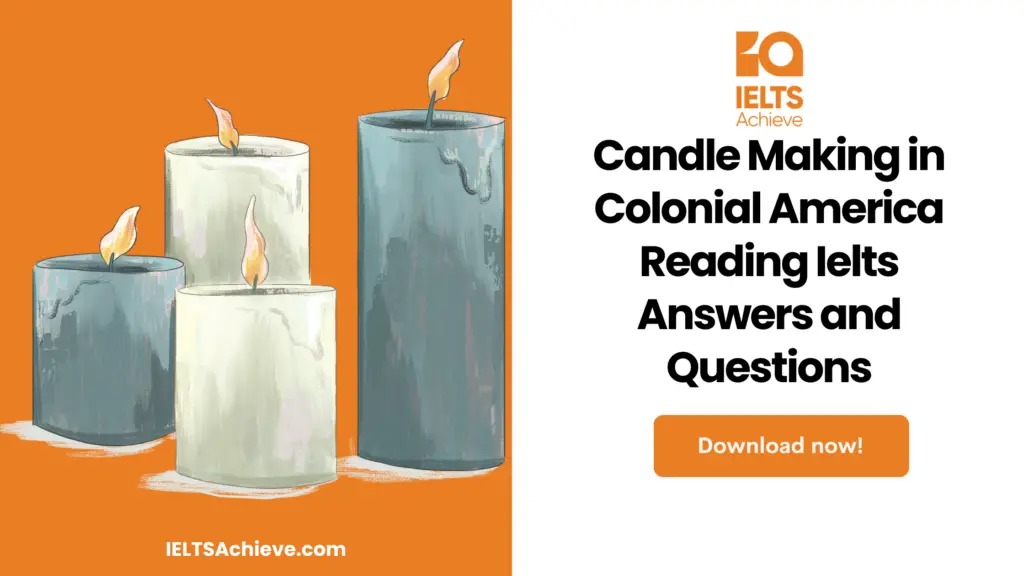The Blog post contains the following IELTS Reading Questions:
- IELTS Reading Multiple Choice Questions
- IELTS Reading Matching Features
- IELTS Reading True/False/Not given
Stay informed and prepared for success – Explore our comprehensive Reading Test Info page to get valuable insights, exam format details, and expert tips for mastering the IELTS Reading section.
IELTS Reading Passage – Candle Making in Colonial America

Candle Making in Colonial America
Paraffin wax, which is generated from petroleum, is the principal component used in candlemaking today. Refiners “crack” crude oil during the refining process, thereby dividing it into distinct products such as gasoline, heating oil, and kerosene. Paraffin wax, which was created by plants 100 to 700 million years ago to preserve their leaves, is inert and remains suspended in the decomposed plant debris that ultimately forms crude oil. Paraffin wax is extracted and sold as a byproduct during the refining procedure.
The discovery of paraffin did not occur until the early 1800s. At that time, paraffin wax was produced by distilling bituminous schist, which is today known as shale oil. Dr. James Young, a Scottish industrial chemist, submitted a patent application in 1850 for the extraction of paraffin oil and paraffin from bituminous coals. Shortly thereafter, under permission from Young, large-scale production of paraffin from coal began in the United States. Young’s initial method for getting paraffin is no longer profitable due to the widespread availability of petroleum; paraffin is currently made from crude oil.
Candle-making had relied on several ingredients for centuries before the discovery of paraffin. Chemically, those substances were also hydrocarbons, but they came straight from plants, animals, or insects.
Beeswax was highly prized throughout America’s colonial era for use in candle making. Even today, beeswax is prized despite being more expensive because pure beeswax candles burn with no smoke while paraffin candles produce dark, greasy soot. Only female worker bees secrete beeswax. Oval flakes of wax form on the underside of a worker bee’s last four abdomen segments as she consumes honey, which causes her wax glands to discharge the wax. The bee then takes out the wax flakes and chews them, softening them by combining them with her saliva. She affixes the wax on the honeycomb after it is sufficiently flexible. Each pocket of the wax comb is filled with honey and sealed with additional wax as it is constructed.
Beekeeping played a significant role in American life in the seventeenth and eighteenth centuries due to the wide variety of uses and high value of not only honey but also of the bees themselves and their beeswax. Many of the original settlers from Europe brought honeybee hives with them. Despite not being native to North America, European honeybees thrived and frequently escaped into the wild. The bees have generally expanded themselves throughout the land, a little ahead of the white inhabitants, Thomas Jefferson wrote in Notes on the State of Virginia in 1785. The Indians refer to them as “the white man’s fly” because they believe that their approach heralds the arrival of white colonists. Eventually, the frontier bartering system that developed in the lack of easily available money was utilized by both the Native Americans and the colonists and involved beeswax and honey.
Animal tallow or fat was another source of wax for colonial candles. The most popular tallow sources were cattle and sheep. Because the candles manufactured from pork fat leaked too much and were unsafe, they were not utilized. In addition, the smell of burning tallows for pork was extremely repulsive. For making candles, chicken and duck fat were too soft. The tallow was cooked in a cauldron until the fat melted, after which it was repeatedly filtered to get rid of as much gristle, meat fibre, and other impurities as possible. Straining decreased the amount of smoke and foul odor the candles produced, but it did not completely stop it. To keep out mice and other creatures that may consume them, tallow candles had to be maintained in tightly covered vessels, which were typically made of tin or wood.
The colonists found a native plant in the New World that was rich in a natural waxy material that could be harvested and utilized to make candles. The tree is a shrub called bayberry, commonly referred to as a candleberry. The thick, semi-evergreen plants are known as bayberries. The plants may reach heights of up to nine feet, are exceptionally hardy, and thrive in coastal soil that is too salty for other types of horticulture. The female plants produce clusters of blue-grey berries throughout the winter, which give the wax its color. The waxy material was separated from the pulp by boiling the berries, and the wax was then skimmed from the top. Although it took more work to make bayberry candles than tallow candles, bayberry candles were far superior since they burned longer and produced less smoke. They also smelled good, which was another plus. Bayberries were more readily available than beeswax, and the colonists discovered that bayberry wax was harder than beeswax and therefore burned for a longer period of time.
The candles were frequently saved for special events, especially Christmas and New Year’s Eve, because the bayberry clusters were collected in the winter and because manufacturing them required a lot of time. The proverb “Bayberry candles burned to the socket, puts luck in the home, food in the larder, and gold in the pocket” was born from them as they eventually became a holiday tradition. The colonial household was extremely fortunate because it had a holiday feast and brightly blazing candles.
Unlock your full potential in the IELTS Reading section – Visit our IELTS Reading Practice Question Answer page now!
Recommended Questions:
Renewable Energy IELTS Reading Question with Answer
Candle Making in Colonial America Reading Questions
Questions 1-3
Write the correct letter A, B, or C, on lines 1-3 on your answer sheet.
1. What is paraffin
A. A by-product of petroleum.
Situated in rocks.
from a certain vegetable.
2. The initial source of paraffin was
A. Crude oil.
B. Rotten vegetable.
C. bituminous coal.
3. Who was James Young
A. Manufacturer of candles.
B. A producer of oil.
C. A scientist
Ready to improve your performance in Multiple Choice Questions (MCQs)? Click here to access our comprehensive guide on how to tackle MCQs effectively in the IELTS Reading section.
Questions 4-10
Classify the following as descriptive of
| A paraffin B beeswax C tallow D bayberry wax |
Write the correct letter, A, B, C, or D, in the boxes 4-10 on your answer sheet.
4. was frequently produced using calf fat.
5. is derived from a shrub that grows close to the ocean.
6. must be purified before being used to make candles.
7. prior to the nineteenth century, it was unused.
8. creates smoke-free candles.
9. manufactured candles that hungry mice and rats found to be appealing.
10. is coloured blue.
Improve your performance in Matching Features questions by clicking here to access our comprehensive guide. Learn how to match specific features or characteristics with the options provided in the IELTS Reading section.
Questions 11-13
Do the following statements agree with the information given in the passage? On the lines, 15-23 on your answer sheet, write
TRUE if the statement agrees with the information
FALSE if the statement contradicts the information
NOT GIVEN if there is no information on this
11. Beeswax was a commodity that European colonists took with them to America.
12. Candles created from soy wax spilled too often and were unsafe.
13. It is the blue-gray berries that the female plants bear in the winter that provide the wax with its distinctive coloration.
Enhance your skills in identifying information as True, False, or Not Given. Click here to discover expert strategies and techniques for mastering this question type in the IELTS Reading section.
Unlock your full potential in the IELTS Reading section – Visit our IELTS Reading Practice Question Answer page now!
Recommended Questions:
Renewable Energy IELTS Reading Question with Answer
Candle Making in Colonial America Reading Answers
- A
- C
- C
- C
- D
- C
- A
- B
- C
- D
- True
- False
- True

We hope you found this post useful in helping you to study for the IELTS Test. If you have any questions please let us know in the comments below or on the Facebook page.
The best way to keep up to date with posts like this is to like us on Facebook, then follow us on Instagram and Pinterest. If you need help preparing for the IELTS Test, join the IELTS Achieve Academy and see how we can assist you to achieve your desired band score. We offer an essay correction service, mock exams and online courses.

